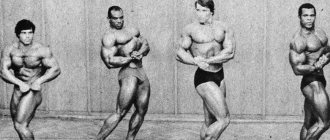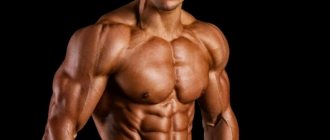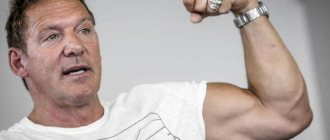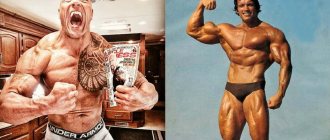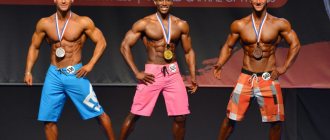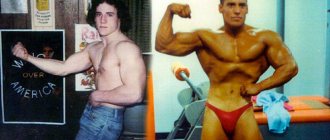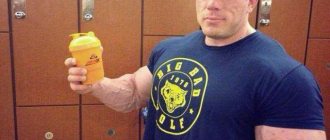In the pre-steroid era, weightlifters had different goals and did not train for magazine pictures and cash prizes in competitive bodybuilding. Future champions were driven by passion, ambition, the desire to break world records, and obtain titles. The story of Larry Scott's rise to the sporting Olympus is proof of what a person is capable of if he has the goal of becoming a champion. Although his career ended at age 28, he is remembered in the history of bodybuilding as the first Mr. Olympia and the designer of the exercise machine that stands in every gym today.
How it all began
Larry Scott was born in October 1938 in Idaho (USA). As a child, he was often sick and was inferior to his peers in physical development. During his teenage years, he realized that if he didn’t take care of himself, he would never get rid of his health problems. Immediately I came across an athletics magazine with a photograph of George Payne and a caption that such results could be achieved in a month. The athlete’s figure impressed the teenager so much that he succumbed to the advertising and began to physically improve his body, lifting spare parts from an old tractor.
The young athlete trained according to the system described in Muscle Builder. Biceps, of course, did not appear in a month, but by the end of summer their diameter was 30 cm. For a guy with a thin build, this was incredible progress. The result inspired the guy even more to sporting exploits, and he worked out for days in the garage, imagining how women in a crowd followed him on the beach in California.
Biography: early years
Larry Scott was born on October 12, 1938 in Blackfoot, Idaho, USA.
His ancestors came from Scotland. Larry's parents had their own farm. In addition to him, there were five more children in the family. Soon they moved to the city of Pocatello, where Larry graduated from school. Scott was very thin since childhood. He was noticeably behind his peers in physical development. Because of this, Larry developed a strong complex, and his peers did not miss the opportunity to make fun of him.
As a teenager, he decided to take up sports. So, Larry was fond of trampolining. This subsequently helped him in the training process when he came to bodybuilding.
Scott started lifting weights at the age of 16. He came to this hobby by accident. One day he came across an old bodybuilding magazine with the famous athlete George Payne on the cover. Larry was very impressed with his muscles, especially his triceps. Under the photo of the athlete there was an inscription that you too can achieve such results in just a month. Larry became obsessed with the idea of becoming as muscular as Payne. He read the magazine in one sitting and immediately began training.
He performed the exercises, strictly following the recommendations from the magazine. Since he didn’t have any training equipment, he started training with a trolley wheel. Three months later, the circumference of his arms was already 30 cm. Scott liked the result, so he began to exercise even more actively than before. He read every issue of a bodybuilding magazine.
Soon he took second place in the school competition “Graduate with the best physique.” This changed his life. In an interview, he recalled that it was then that he believed in himself for the first time. Since then, he has tried not to miss a single workout.
In those days, the attitude towards bodybuilding in society was different than it is now. Athletes built muscle “naturally”. Steroids were just beginning to appear at that time, and not all athletes decided to take them. Larry refused chemistry.
After graduation, Scott continued his studies at the College of Aeronautics, which was located in California. There he studied electronics. His choice was deliberate. At that time, the best bodybuilders lived in California. The Bert Goodrich Health Center was located next to the college. Within its walls, Scott continued the training process. Only now he was not of an amateur, but of a professional nature.
First successes
Soon the thought struck him that he had outgrown amateur training. The young man was admitted to the California College of Aeronautics, next to the health center, where he continued his training. Here he meets bodybuilders Lou Denis and Vince. The pros appreciated the guy’s molded biceps and his efforts, and began helping him in his training.
Under their mentorship, in his first competition for the title “Mr. Los Angeles”, he took 3rd position. The young man did not count on such success. The ultimate dream was only 5th place. This victory brought him 2 steps closer to his long-time dream - winning the tournament for the title of "Mr. America".
Victories and awards
Events were in the guy's favor. At the competition, he is noticed by Joe Weider, a famous coach and organizer of the Mr. Olympia competition. He invites Larry to come under his patronage. The idea turned out to be successful. At the age of 25, the bodybuilder wins Mr. Universe and consolidates his success in 1964 - 1966. At 28, handsome Larry was awarded the Mr. Olympia title . A step lower next to him stood the famous bodybuilders Harrold Pulo and Aird Maynard. The following year he repeated the success again at the Olympia . According to Larry, recent awards pushed him to decide to leave. The athlete realized that the peaks had been conquered, and it was time to move on to other things. He got married and wanted to enjoy life.
| Year | Competitions | Place |
| 1963 | Mister Universe | 1 in the category average height |
| 1964 | Mister Universe | 1 in the category average height |
| 1964 | Mister Universe | 1 |
| 1965 | Mr. Olympia | 1 |
| 1966 | Mr. Olympia | 1 |
| 1979 | Canada Diamond Pro | 9 |
| 1979 | Grand Prix Vancouver | — |
Features of the exercise
The first Mr. Olympia has repeatedly stated that it was this type of bench press that helped him develop his deltoids to incredible volume. The exercise is essentially a modernized version of the shoulder press.
The load in the Scott press concentrates on the deltoid muscles of the shoulders, especially on their middle bundles. At the stage of mastering it, it is recommended to practice in front of a mirror. This will make it more convenient for you to control the equipment.
The only thing you need for the bench press is dumbbells, kettlebells or other weights. It doesn’t matter what you have in your hands – even a bottle of water. However, the famous athlete does not recommend doing shoulder exercises with a barbell, as they create excessive stress on the joints.
Anthropometry
A thin guy with narrow shoulders achieved excellent results. The muscular figure was distinguished by huge deltoids and biceps. Today, such parameters will not surprise anyone. Considering that in the mid-60s steroids had just appeared on the sports horizon, and no one had even heard of Synthol injections into muscles, this was progress.
- With a height of 170 cm;
- Larry Scott's bicep circumference was 50 cm;
- torso - 64 cm;
- waist - 76 cm;
- the weight in the off-season did not exceed 102 kg, after drying - 94 kg.
Larry Scott's training program
To achieve such forms, the athlete tried not a single technique. As a result, his inquisitive mind led to the invention of the “Scott bench ,” which he called a music stand. The design was accompanied by a set of exercises that required sequential execution. Few people know about this system today, because... athletes more often give preference to other exercise equipment, advertised programs, or reinvent a “new wheel.”
Triple sets from Larry Scott
The principle of an integrative approach to pumping up biceps is based on trisets, and the number of repetitions (3-5) depends on the individual capabilities of the athlete. Exercises begin with “hot” biceps according to the scheme:
- synchronized dumbbell lifts: 6 repetitions with full amplitude and 4 partial. At the end, cheating is used to “finish off” the bunches. It also loads the muscles well and, in addition, protects strained ligaments from sprains.
- barbell row with a straight bar. The exercise eliminates cheating and requires perfect execution of the technique. To facilitate the task and immobilize the body, the feet are brought forward.
- reverse lifts with EZ bar. Cheating is allowed at the end. The number of repetitions in all exercises is the same.
Perform exercises slowly with pauses between sets, excluding delays during transitions to the next exercises.
It is important not to change the sequence and vultures, otherwise the whole system loses its meaning.
The principle is simple:
- the first technique is aimed at developing the external heads;
- the second - for pumping internal ones;
- then the “swayed” brachialis push up the internal tufts, giving the arms visual volume.
Together with the brachialis, the forearms are well pumped, which allows you to move to a higher level of strength training.
Description of the technique
To begin performing the Scott Press, take a starting position as if you were about to do a classic shoulder press. You can do the exercise standing or sitting - the main thing is that your back remains straight.
Take dumbbells with an overhand grip and rotate your hands so that your little fingers are over your thumbs. If you had the already mentioned bottles of water in your hands, with such a grip, water would begin to pour out of them, since the neck would sink below the bottom. Although this grip may seem very strange to you, it must be maintained throughout the entire movement. This is the key feature and secret of the success of the Scott press.
When the hands and dumbbells occupy the position described above, the triceps are switched off from work as much as possible. This makes the movement much more efficient. In all other exercises for developing the delta, this factor is not taken into account. Because of this, progress becomes noticeable much later.
After you take the starting position and fix the correct grip, you can begin the exercise.
- Exhale and press the dumbbells overhead without fully straightening your elbows. If you straighten your arms completely, the deltoids will stop working. Keeping your elbows bent will help keep them tense throughout the exercise.
- As you inhale, relax your arms and slowly return to the starting position. Larry advises using the negative phase of the movement as much as possible rather than throwing the dumbbells down quickly.
To gain shoulder muscle mass, it is recommended to do this exercise for 8-12 repetitions in 3-4 sets.
Life outside of big sport
Despite the fact that he no longer competed, Larry continued to train and stay in shape. In 1978, at the age of 39, Schwarzenegger asked him to perform as a guest at Olympia. The admiring audience bathed the ex-Mr. in 60 minutes of applause. Even in his old age, Scott was still in shape and could be proud of his biceps.
Having moved to Utah (Salt Lake City), the champion opened a company producing inexpensive but high-quality sports nutrition, and an enterprise for sewing equipment for athletes. He also had several fitness clubs, which he personally ran. He lived as befits a sports star of this rank: he gave interviews, appeared on television, wrote books.
Today, the famous athlete is spoken of in the press and on television in the past tense. Larry Scott is no longer with us. He passed away in 2011. His health was affected by Alzheimer's disease. But he was and remains an example for all athletes. Today, his titles and awards can be seen in the IFBB Hall of Fame, which were exhibited back in 1999.
Links[edit]
- ^ abcd Alberti, Erin and Carlisle, Nate (March 11, 2014). "Larry Scott, Utah and World Bodybuilding Star, Dies at 75". The Salt Lake Tribune
.CS1 maint: multiple names: list of authors (link) - "Larry Scott". libero.it
. - ^ ab Carlisle, Nate (March 11, 2014). "Utah Funeral Planned for Bodybuilder Larry Scott". The Salt Lake Tribune
. - "Larry Scott, the bodybuilder who inspired Schwarzenegger, dies at 75". New York Times
. - "Larry Scott". IMDb
. - "Larry Scott's Fitness and Nutrition". larryscott.com
. - "Radio Interview with Mr. Olympia Larry Scott".
- ↑
Los Angeles Times (March 13, 2014).
“Larry Scott dies at age 75; bodybuilding champion." latimes.com
.
